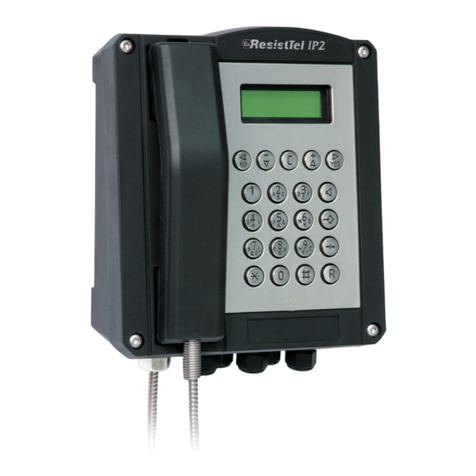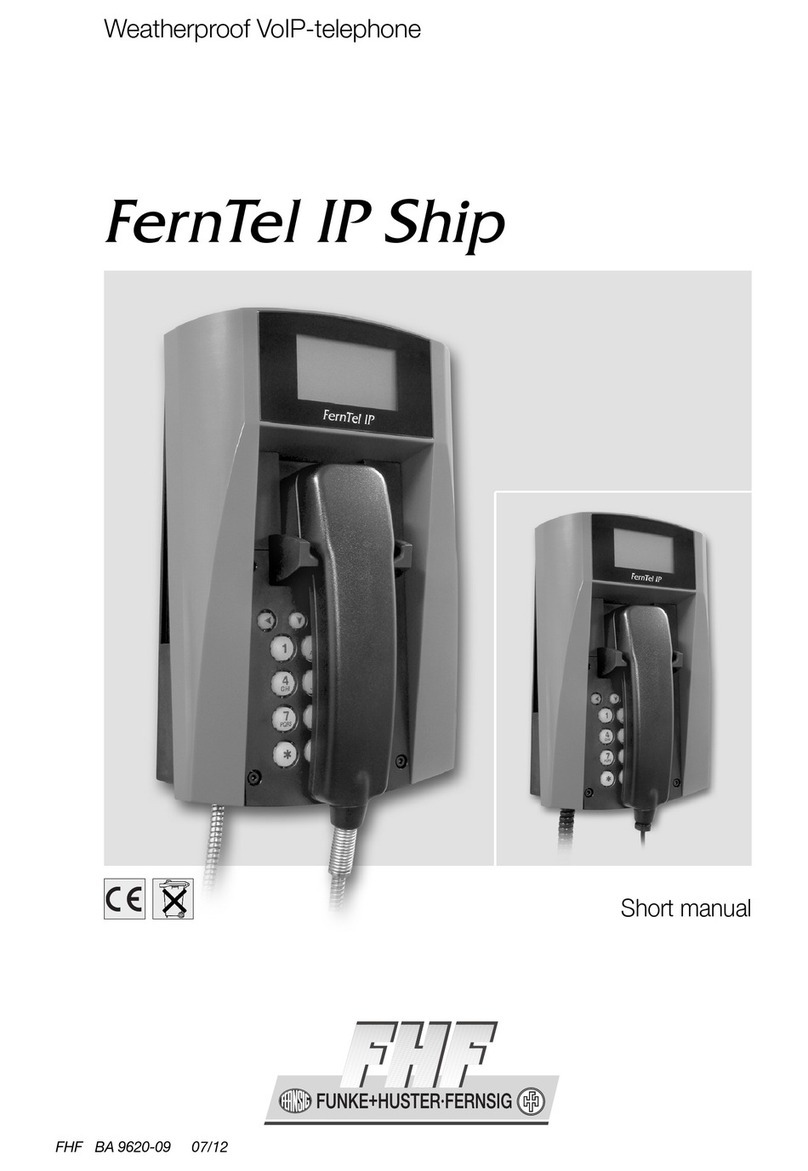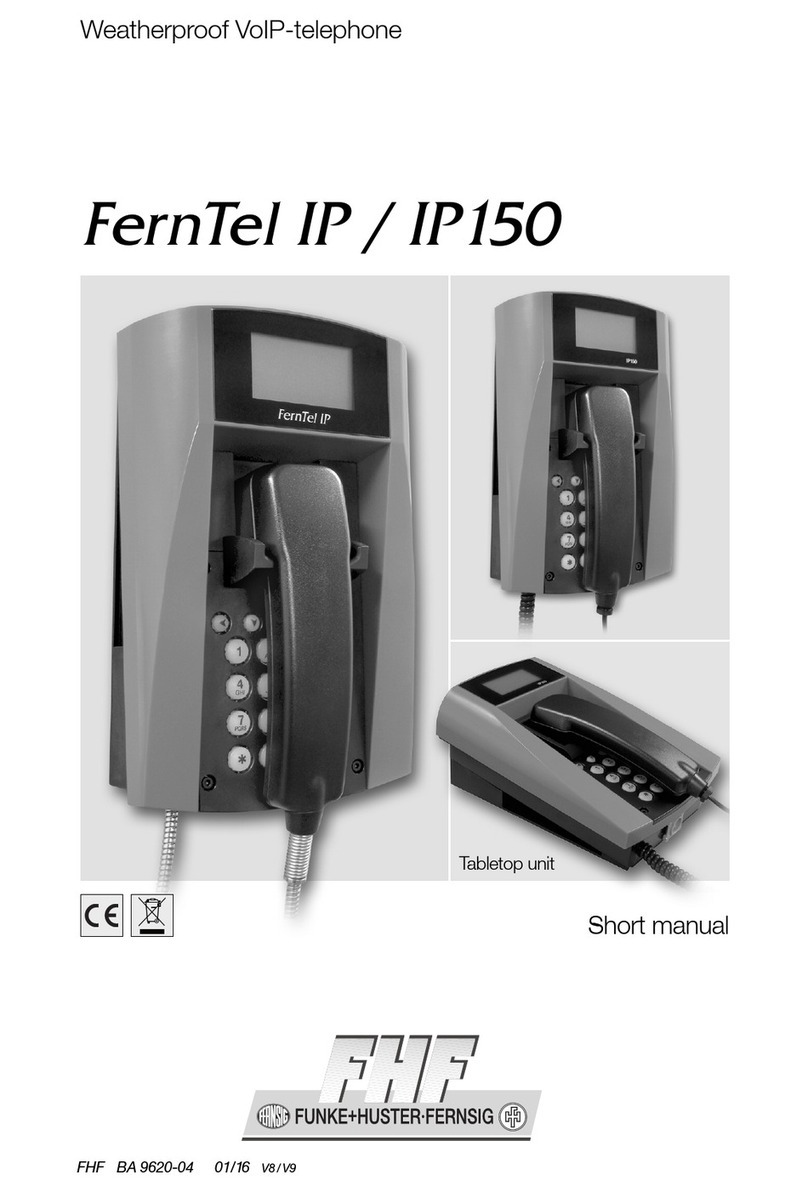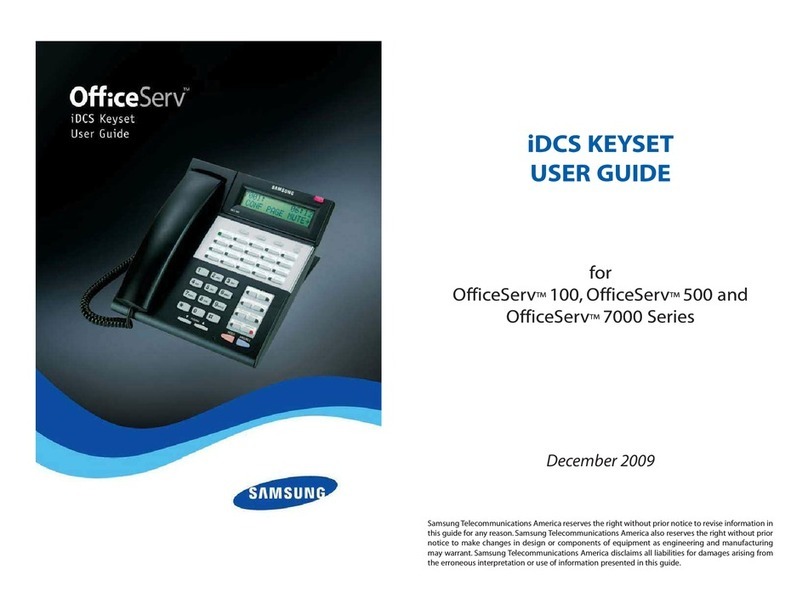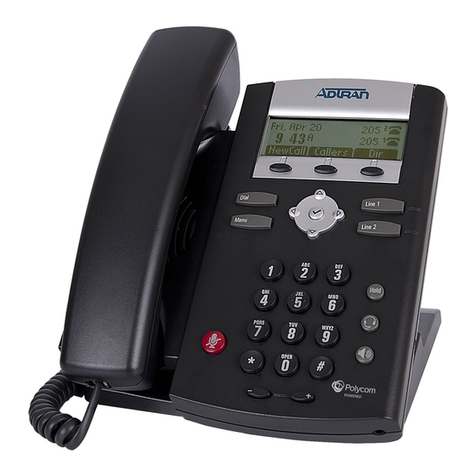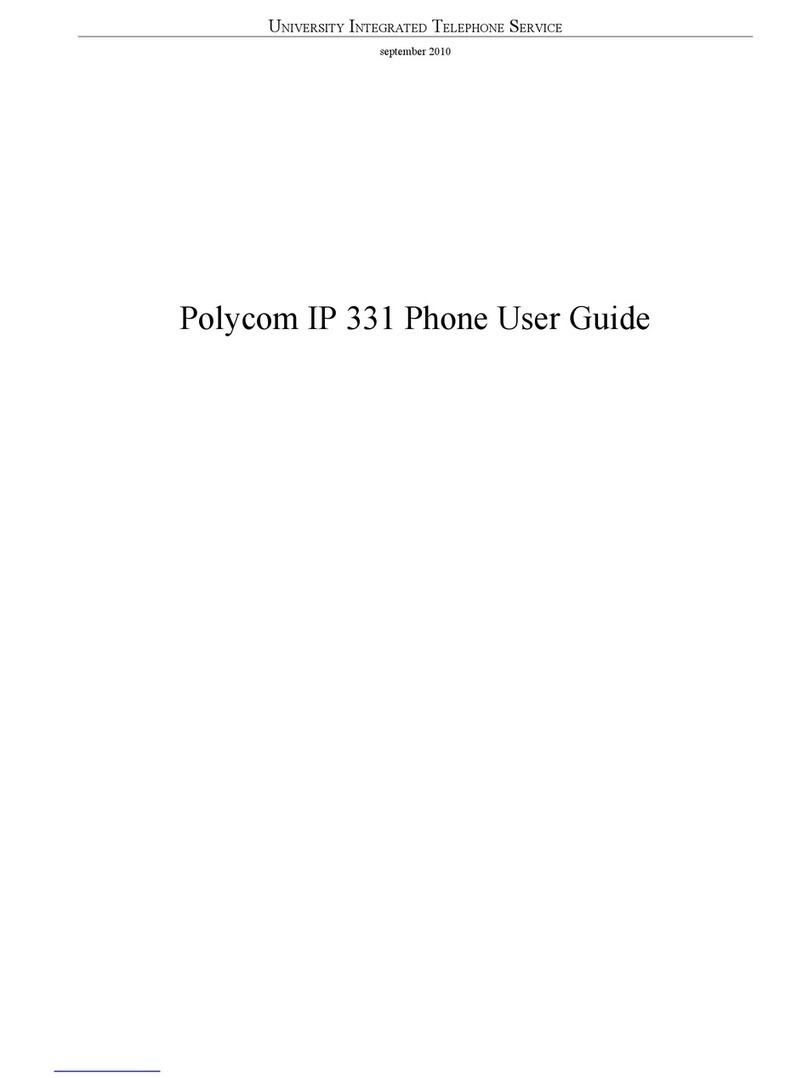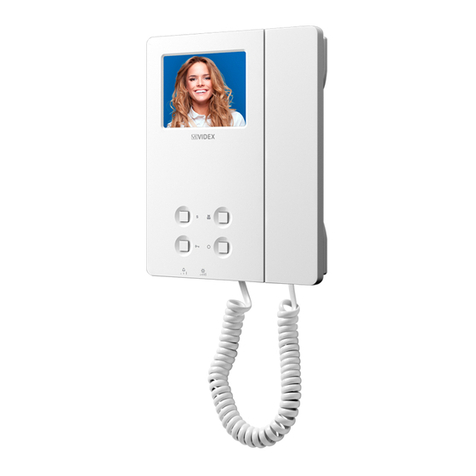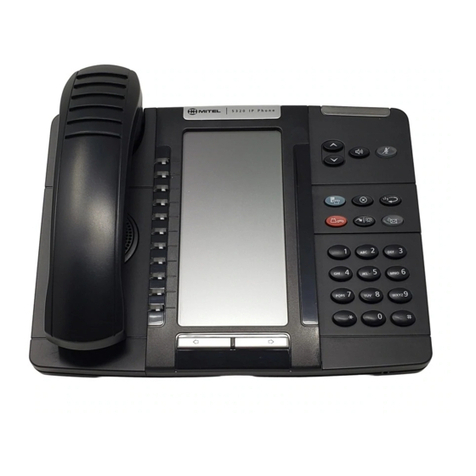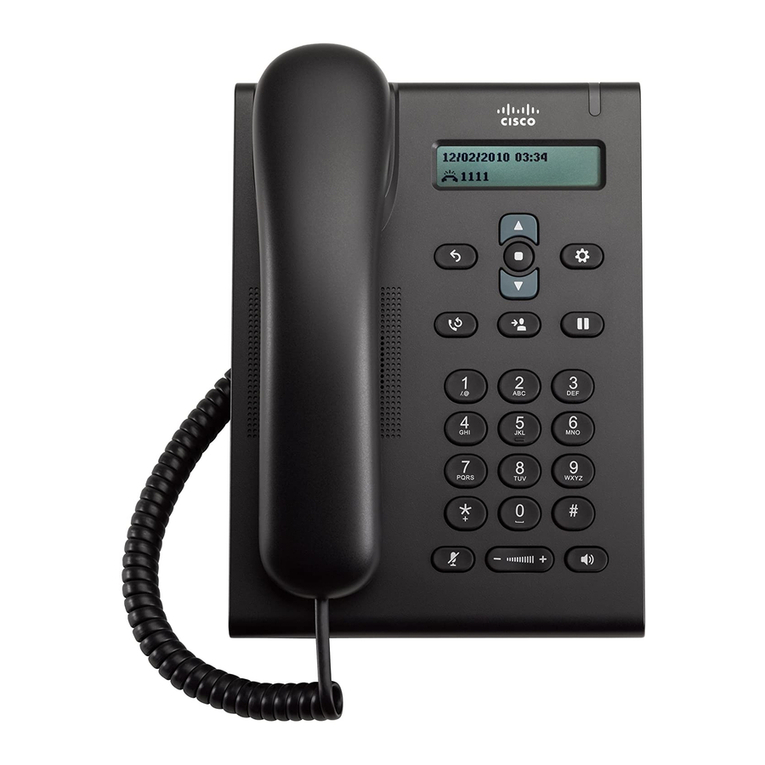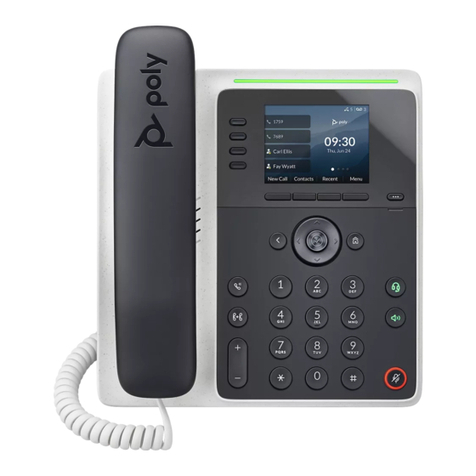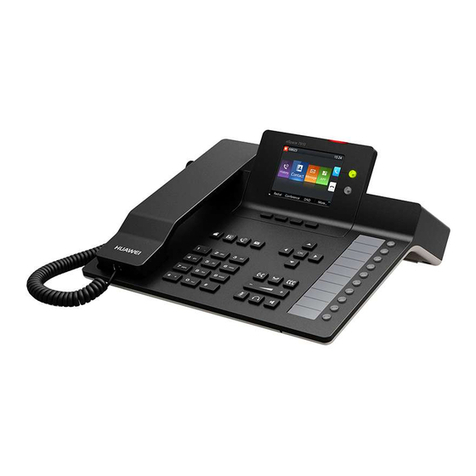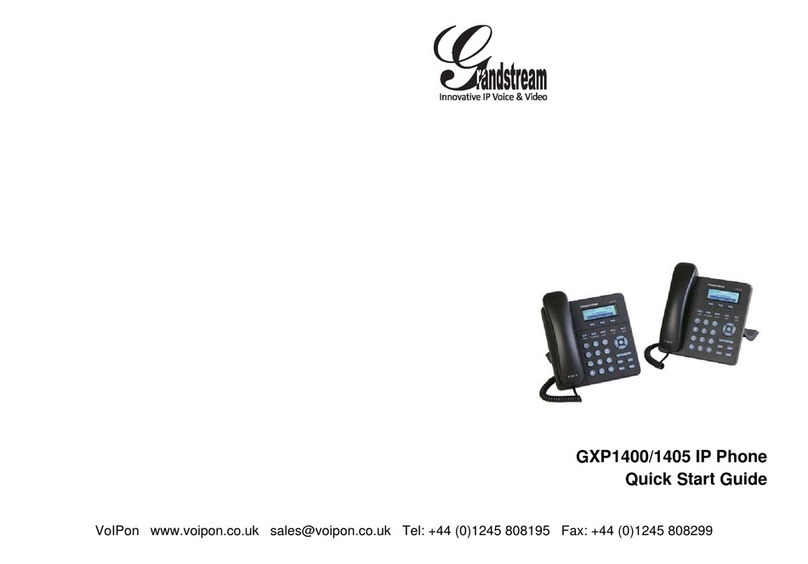FHF ExResistTel User manual

Telepho e for Hazardous Locatio s
Operati g i structio s
FHF BA 9703-01 03/15

2
Foreword
Our telephone ExResistTel/ExResistTel ZB is a captivating product on
account of its precision, convenience, long service life and reliability. It is
freely programmable and the optimum choice for adverse ambient con-
ditions. Be it seawater, high atmospheric humidity, dust or the toughest
mechanical strains, the weather-resistant telephone accomplishes its
aim in any conditions. The reason for this is the robust keypad made of
V4A steel and an extremely solid housing made of impact-resistant and
shockproof cast-moulding material. All of the components utilised are
even resistant to leeches and lubricants. The 21-button V4A-steel key-
pad - which can be operated by a user wearing gloves - and the easily
readable alphanumeric display as well as the uncomplicated menus all
ensure simple operation - thus fulfilling the requirements for a leading-
edge and operationally reliable means of communication. As a tele-
phone suitable for connecting to the public telephone network and to
private automatic branch exchanges, the ExResistTel always ensures
reliable connections.
ExResistTel ZB is designed for telephone exchange operation and
corresponds to the ExResistTel, except for keypad and display.
Note
Please read the operating manual carefully before installing the device.
Please check the contents of the box for completeness.
This equipment is suitable for use in Class I, Division 2, Groups A,
B, C, D or non-hazardous locations only.
Cet appareil est qualifié à être utilize en locaux classes Class I,
Division 2, Groups A, B, C, D ou seulement dans les emplacements
non-dangereux.
WARNING – Do not disconnect equipment unless power has
been switched off or the area is known to be non-hazardous.
AVERTISSEMENT – Déconnectez pas l´appareil avant que
l´alimentation est mise hors tension ou l´emplacement est
considéré à être non-dangereux.
WARNING – Explosion hazard – Substitution of any component
may impair suitability for Class I, Division 2.
AVERTISSEMENT – Risque d´explosion – Remplacement d´aucun
composant peut affaiblir aptitude pour Class I, Division 2.

3
Table of contents
General operating instructions ................................................................ 5
Customer information.............................................................................. 5
Device ..................................................................................................... 7
Device – construction .......................................................................... 7
Variant ExResistTel ZB notes .......................................................... 7
Device – drawings of the housing ....................................................... 8
Device - connection diagram............................................................. 11
Device – display and keypad............................................................. 12
Display icons.................................................................................. 12
Key functions ................................................................................. 13
Device – mounting and installation.................................................... 14
Device – adjusting sling holder.......................................................... 15
Device – start-up ............................................................................... 15
Device – maintenance....................................................................... 15
As delivered condition – box contents .................................................. 15
As delivered condition – default settings............................................... 16
Operation .............................................................................................. 17
Operation – conversation modes ...................................................... 17
Handset conversation mode .......................................................... 17
Open listening conversation mode ................................................ 17
Handsfree conversation mode....................................................... 17
Headset conversation mode .......................................................... 17
Operation – answering calls .............................................................. 18
Operation – making calls................................................................... 18
Operation – when the phone is locked .............................................. 19
Configuration......................................................................................... 19
Configuration - Main Menu (Overview).............................................. 20
Configuration - Phone Book .............................................................. 21
Configuration - Ringer ....................................................................... 21
Configuration - Volume...................................................................... 21
Configuration - Dialing Mode ............................................................. 22
Configuration - PBX\PSTN ................................................................ 22
Calls to the PSTN .......................................................................... 22
Inquiries ......................................................................................... 22
Configuration - F-Relay ..................................................................... 23
Configuration - Menu......................................................................... 23
Configuration - Fact. Settings ............................................................ 23
Configuration - PIN............................................................................ 24
Configuration - Phone Lock ............................................................... 24
Configuration - Menu Lock ................................................................ 25
Configuration - Version...................................................................... 25

4
Menu ..................................................................................................... 26
Menu – used confirmation-, error- and advisory tones ...................... 26
Menu – using menus ......................................................................... 26
Menu – using sliders.......................................................................... 27
Menu – using options ........................................................................ 27
Menu – using input lines.................................................................... 28
Menu – using phone book .................................................................29
Technical Data ......................................................................................31
Service .................................................................................................. 33
Service – maintenance ...................................................................... 33
Service – waste disposal ................................................................... 33
Service – warning and safety instructions ......................................... 34
Identification .......................................................................................... 35

5
General operating instructions
1. Both the ExResistTel telephone and the ZB version are designed for
connection to dial ports with analogue connection points.
2. The handset is fitted with a stray-field coil for connecting hearing-
aids. People who use hearing-aids which have an inductive receiver
can receive the earphone signal directly.
3. The ZB version is not equipped with keypad and display, therefore
not all the features are available with this version.
4. The ExResistTel has a handset module with a dry reed contact as a
hook switch. In order to terminate an existing call connection, the
handset must be hung up. In order to interrupt an existing call con-
nection, it is sufficient to press the disconnect key on the key-
pad.(see page 12)
5. Use the menu to program the appropriate settings. To access the
menu, pick up the handset and press the "YES" key.
6. If you take longer than 2 minutes before you begin making a choice,
the power supply of the exchange may be switched off. If that
occurs, you will no longer hear a dialling tone. In that case, please
replace the handset and wait 2 seconds before picking it up again.
7. When a setting is stored successfully, this is confirmed by an
acknowledgement tone.
8. When you receive a call, the ExResistTel rings at the ringer-volume
level selected by you and, for the duration of the calling sound, the
symbols ( ( ( ) ) ) appears on the display.
9. If you enter a PIN with the menu you can restrict or block settings
and dial functions. Forgetting the PIN is the equivalent of losing a
key. If you forget the PIN, please contact our technical support.
Customer information
This device has been tested and found to comply with the limits for a
class B digital device, pursuant to part 15 of the FCC rules.
This device complies with part 68 of the FCC rules and with the stan-
dard TIA 968B.
The REN (Ringer Equivalence Number) is used to determine the num-
ber of devices that may be connected to a telephone line. Excessive
RENs on a telephone line may result in the devices not ringing in re-
sponse to an incoming call. In most but not all areas, the sum of RENs
should not exceed five (5.0). To be certain of the number of devices that
may be connected to a line, as determined by the total REN, contact the
local telephone company. The REN is part of the product identifier and
has the format REN n.n.B. The letter B denotes the ringer type.
If this telephone causes harm to the telephone network, the telephone
company will notify you in advance that temporary discontinuance of

6
service may be required. But if advance notice isn´t practical, the tele-
phone company will notify the customer as soon as possible. Also, you
will be advised of your right to file a complaint with the FCC if you
believe it is necessary.
The telephone company may make changes in its facilities, equipment,
operations or procedures that could affect the operation of the device. If
it happens, the telephone company will provide advance notice in order
for you to make necessary modifications to maintain uninterrupted
service.
If trouble is experienced with this telephone, for repair or warranty
operation, please contact your supplier.
If the device is causing harm to the telephone network, the telephone
company may request that you disconnect the device until the problem
is resolved.
If you have specially wired alarm equipment connected to the telephone
line, ensure the installation of this telephone does not disable your alarm
equipment. If you have questions about what will disable alarm equip-
ment, consult your telephone company or a qualified installer.
This telephone must not be used on party lines.
This telephone is of a type that is not intended to be repaired.
This telephone is hearing aid compatible (HAC).

7
Device
Device – construction
The two-part housing of ExResistTel consists of an electrostatically
conducting compressed material into the top portion of which a stainless
steel front plate is inserted. A cut-out closed with a sight glass in the
front plate, is arranged over the display of the telephone.
A trough for incorporating cast electronic modules, as well as a connec-
tion compartment into which up to four leads can be introduced, is built
into the box shaped lower part. The upper part with keypad and display
section is compressed onto the lower part along with an intermediate
circumventing gasket with the help of four screws and seals off the in-
ternal space.
Variant ExResistTel ZB notes -------------------------------------------------------
ExResistTel ZB is a variant of the telephone that has neither a display
nor a keypad and can be used in centralised operation applications
(ZB). Differing from the identical handling of incoming calls, the ZB
variant is passive during outgoing calls. The private branch exchange
used is responsible for dialling or establishing a voice connection, which
should be configured accordingly if required.
Apart from the display and keypad, the variant ExResistTel ZB has the
technical data of the standard variant ExResistTel at delivery. All keys,
display and setting dependent statements in the operating manual do
not necessarily apply to the ZB variant. The operation with a headset is
also not possible. For a better overview, the use of an explicit identifica-
tion such as "not applicable for the ZB variant" of all affected passages
has been avoided.

8
Device – drawings of the housing
Figure 1 Set view.
Device version ExResistTel ZB is not equipped with keypad and display.
The front plate of this version is a closed stainless steel plate.
UPPER%PART%OF%
THE%TELEPHONE%

9
Figure 2 Outside view of telephone lower part.
Note: Pos. 17, 18 and 19 are only used when the headset is connected.
LOWER%PART%OF%
THE%TELEPHONE%

10
Figure 3 Inside view of telephone upper part.
Note: The ZB version is not equipped with a pin contact strip.
UPPER%PART%OF%
THE%TELEPHONE%

11
Figure 4 Inside view of telephone lower part and mounting holes
For making a drilling template please see dimensions.
Device – connection diagram
Follow the instructions on page 23 of this manual for configuring the used
relay.
Figure 6 Connection diagram
LOWER%PART%OF%
THE%TELEPHONE%

12
Device – display and keypad
Display icons -----------------------------------------------------------------------------
Symbol Meaning
Key is active: dials the last dialled telephone number (call redial).
not used
Tone dialling is set.
1Key is active: Opening of the menu "unlock” ↔menu navigation
1Key is active: Temporary reduction (-) of the volume ↔menu navigation
1Key is active: not used ↔delete character
1Key is active: Temporary increase (+) of the volume ↔menu navigation
1Key is active: Opening of the "main menu" ↔menu navigation
Impulse dialling is set.
The conversation takes place in the mode: Headset.
The conversation takes place with the loudspeker on in the mode Open Listening
or Handsfree.
1Key function changes depending on state. Statements describe the key function in the
basic state or with open menu. (Key x is active: basic state ↔menus).

13
Key functions ----------------------------------------------------------------------------
Temporary volume setting and menu control
S 12, Display icons
1
Manual dialling or entry of numbers and text.
S 18, Operation – making calls
S 28, Menu – using input lines
Control of the conversation-mode.
S 17, Operation – conversation modes
Disconnecting a connection with handset lifted.
Redialling the last dialled telephone number.
S 18, Operation – making calls
2
Introducing a query.
S 18, Operation – answering calls
S 18, Operation – making calls
1For text entry, the key enables switching between upper case- [ABC] and lower case
[abc]. S 28, Menu – using input lines
2For telephone number entry, the key enables the entry of special dialling characters
(R, A, B, C, D, - & T). S 28, Menu – using input lines
Notes:
Automatic key repetition of the telephone is active on opening of
menu functions. After an initial delay of 500 ms, key events are re-
peated at an interval of 125 ms as long as the key is pressed. This
way, the browsing of the telephone directory, the adjusting of sliding
controllers, the shifting of cursor positions etc. is simplified.

14
Device – mounting and installation
a) The device may only be installed on an even surface and in a vertical
position. Provide the selected area of installation with suitable holes
for fastening the device. The diameter of the drilled hole is depend-
ent on the screw employed (screw diameter max. 5/16” [8 mm]) and
the type of supporting base material (steel, wood, concrete, plaster-
board etc.) and must be chosen accordingly.
S 11, Figure 4 Inside view of telephone lower part ..
b) Loosen (2) cover screws, pull out plug connectors (7)
Figure 4, of
the flat cable from the pin contact strip (21)
Figure 3, of the upper
part of the telephone (1) and take off the upper part.
S 8, Figure 1 Set view
In case headset accessory is used.
c) Screw on the (17) handle from the accessory packing with the help
of the two supplied screws (18) onto the rear side of the telephone
(3).
S 9, Figure 2 Outside view of telephone lower part
d) Remove sealing plugs (6) from the lower part of the telephone (3)
and screw in cable entry gland M20x1.5 (19)
Figure 2, from the
accessory packing.
S 11, Figure 4 Inside view of telephone lower part and mounting
holes
e) Insert screws with head diameters of 0.3937 in [10 mm] to 0.51181 in
[13 mm] in the openings (20) of the lower part of the telephone (3)
secure the lower part of the telephone (3) onto the prepared installa-
tion surface.
S 11, Figure 4 Inside view of telephone lower part and mounting
holes
In case headset accessory is used.
f) Pass the prefabricated connecting cables from the accessory pack-
ing through the cable entry gland M20x1.5 (19) and fix them with the
help of the screw fasteners.
S 9, Figure 2 Outside view of telephone lower part
g) Place the cable core ends of the connecting cables on the terminals
located in the section HEADSET of the connecting diagram. The
terminals are labelled with the cable core colours of the connecting
cables.
S 11, Figure 6 Connection diagram
h) Pass and fix the connecting cables of the telephone through the
cable entry glands (5).
S 11, Figure 4 Inside view of telephone lower part and mounting
holes

15
i) Place the tip/ring cable core ends of the connecting cables on the
terminals located in the section TELEPHONE NETWORK LINES of
the connecting diagram and marked as TIP or RING.
S 11, Figure 6 Connection diagram
In case relay contacts are used
j) Pass and fix the switching contact connecting cables through the
cable entry glands (4).
S 11, Figure 4 Inside view of telephone lower part and mounting
holes
k) Place the cable core ends of the switching contact connecting cables
on the RELAY of the connecting diagram. In the case of a DC-load,
terminals labelled as DC or DC+ must be used; in case of AC switch-
ing load, the two terminals labelled AC ~ must be used.
S 11, Figure 6 Connection diagram
l) Check for proper sealing before placing the upper part of the tele-
phone.
m) Insert the plug connectors (7) of the flat cable into the pin contact
strip (21) of the telephone upper part (1) and place the upper part on
the telephone lower part (3).
n) Fix the telephone upper part (1) with the four cover screws (2).
Device – adjusting sling holder
The holding strength for the handset is continuously adjustable. Loosen
the screws (15) and move the stopping catches (16). Pushing the stop-
ping catches together increases the holding strength whereas pulling
them apart reduces it. Tighten the screws again.
Device – start-up
The ExResistTel telephone is ready for operation as soon as it has been
connected to the telephone network.
Device – maintenance
The ExResistTel telephone contains no parts that have to be main-
tained.
As delivered condition – box contents
The scope of delivery includes:
- ExResistTel telephone
-this operating manual
-2 self-adhesive lettering

16
As delivered condition – default settings
To enable you to use the telephone immediately after connecting it, we
have made default settings for general utilisation purposes.
Using the menu, you can alter these default values in accordance with
your own personal necessities and connection requirements.
Upon delivery of the telephone, the following default values are set:
•Phone book empty
•Ringer volume 6
•Ringer melody 0
•Handset volume 1
•Headset volume 2
•Open listening volume 5
•Handsfree volume 5
•Dialing mode Dual Tone Multi Frequency (DTMF)
signal duration 90 ms
•Exchange code empty
•Pause after
exchange code 1 second
•F-Relay both relays AC/DC are steadily off
•Menu language English
•Welcome text none
•LCD contrast 5
•PIN 0000
•Telephone lock off
•Direct call number empty
•Menu lock off
•Last number redial empty
•Recall key function flash duration 120 ms
Using the programming menu, you may reset the settings to their de-
faults at any time.

17
Operation
Operation – conversation modes
Types of conversation-operations for telephone calls that are available
to you are listed below. To set and change the selected types of oper-
ation, the handset and speaker key Figure 7 must be operated as
shown.
Figure 7 Conversation modes of the ExResistTel.
Handset conversation mode
The conversation must be conducted over the microphone and earpiece
of the lifted handset; the speaker is switched off.
Open listening conversation mode
The conversation must be conducted over the microphone and earpiece
of the lifted handset. Persons present can listen in to the conversation
over the switched-on speaker.
Handsfree conversation mode
The conversation must be conducted over the microphone that is
located below the keypad and the switched-on speaker. Persons pres-
ent can listen in to the conversation and participate actively in it.
Headset conversation mode
The conversation must be conducted over the microphone and earpiece
of the connected headset; the speaker is switched off.

18
Operation – answering calls
The telephone signals an incoming call. Lift the handset or press the
speaker key to accept the call in the conversation-operation type pre-
ferred by you. The greeting message appears in the display and the
connection to the calling party is established.
-------Conversation------
Temporarily lower the volume for the duration of the call.
Temporarily raise the volume for the duration of the call.
Make a query.
Operation – making calls
Lift the handset or press the speaker key to make the call in the conver-
sation-operation type preferred by you. The greeting message appears
in the display and you will hear the dial tone (dial ready tone) of the
public telephone network or of the private branch exchange. Dial the
telephone number of the dialogue partner.
-----------Dialling----------
.. Manual entry and simultaneous dialling of the telephone number.
Dialling the last dialled telephone number.
x 2 set telephone number in telephone directory manually | - or by entry of a
search word and trigger dialling procedure with 1-2 key operations.
S 29, Menu – using phone book
-------Conversation------
Temporarily lower the volume for the duration of the call.
Temporarily raise the volume for the duration of the call.
Make a query.

19
Operation – when the phone is locked
In the case of active telephone lock, dialling is restricted or completely
blocked. The lock, which is active, will be shown as follows in the sec-
ond line of the display on shifting to the selected conversation-operation.
Phone Book Only those telephone numbers listed in the telephone
directory can be dialled. For this, the telephone directory
must be opened by key activation , the chosen tele-
phone number set manually | - or by entering a
search word and triggering the dialling by activating a
key .
S 29, Menu – using phone book
Direct Call Only the numbers listed in the MainMenu\
PhoneLock\DirectCallNo can be dialled. For this, any
key except the keys and can be pressed to trigger
the dialling.
Total Lock Dialling is completely blocked.
------ Conversation ------
Opens the "Unlock" menu with which the telephone lock can be deactivated.
Temporarily lower the volume for the duration of the call.
Temporarily raise the volume for the duration of the call.
-----Unlock-----
Menu "Unlock"
> for good
Deactivates the telephone lock permanently.
this once
Deactivates the telephone lock for the duration of the current
connection.
======End=======
Configuration
The ExResistTel is provided with a menu with which the different prop-
erties of the telephone have to be adapted to the prevailing operating
conditions. This menu marked "Menu Main" is to be opened pressing
the key . Adjustable properties, their factory settings and adjustment
ranges are explained in detail below. Explanations such as those
required for setting of required menu elements, can be found in
S 26 Menu.

20
Configuration - Main Menu (Overview)
This manual suits for next models
1
Table of contents
Other FHF IP Phone manuals

